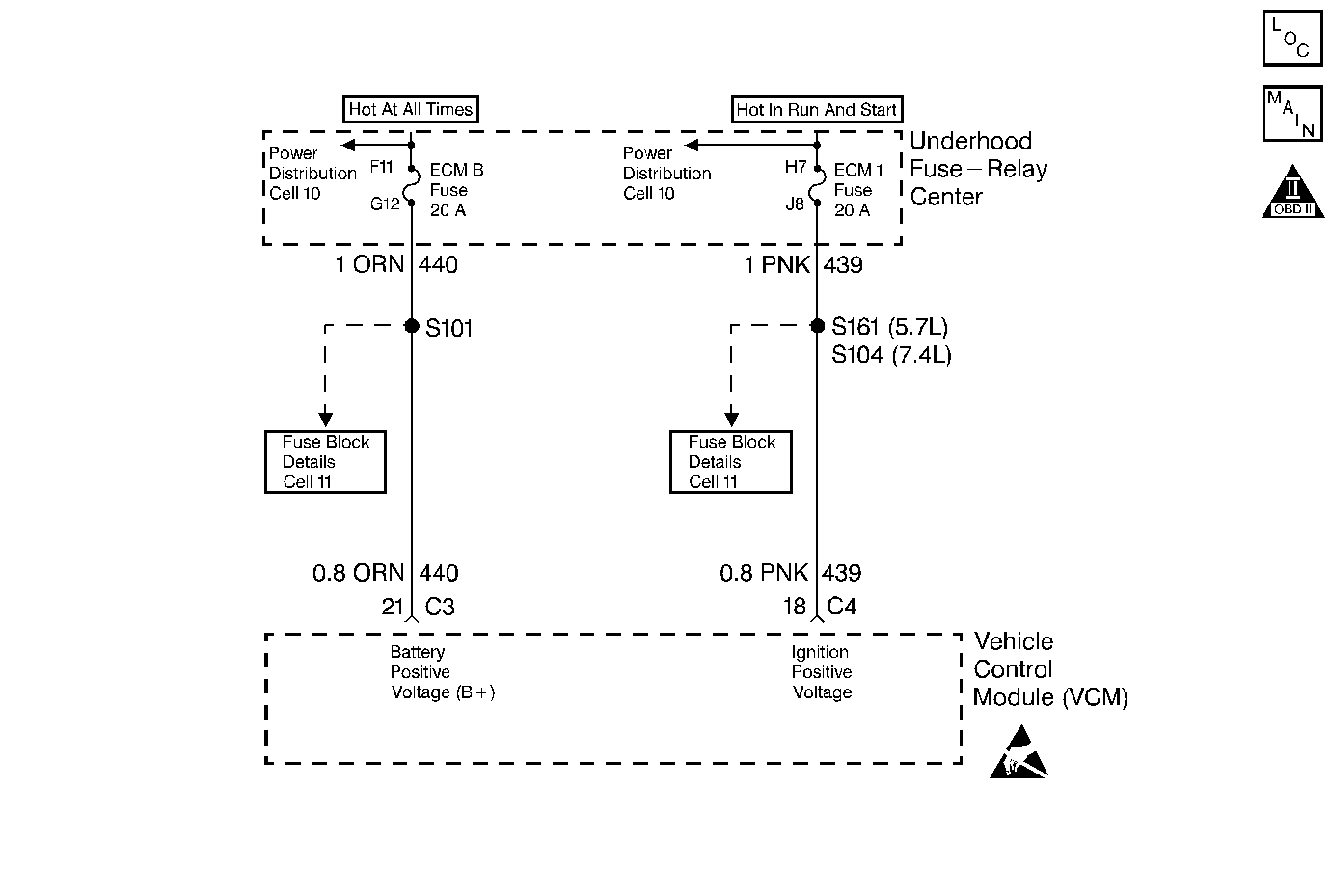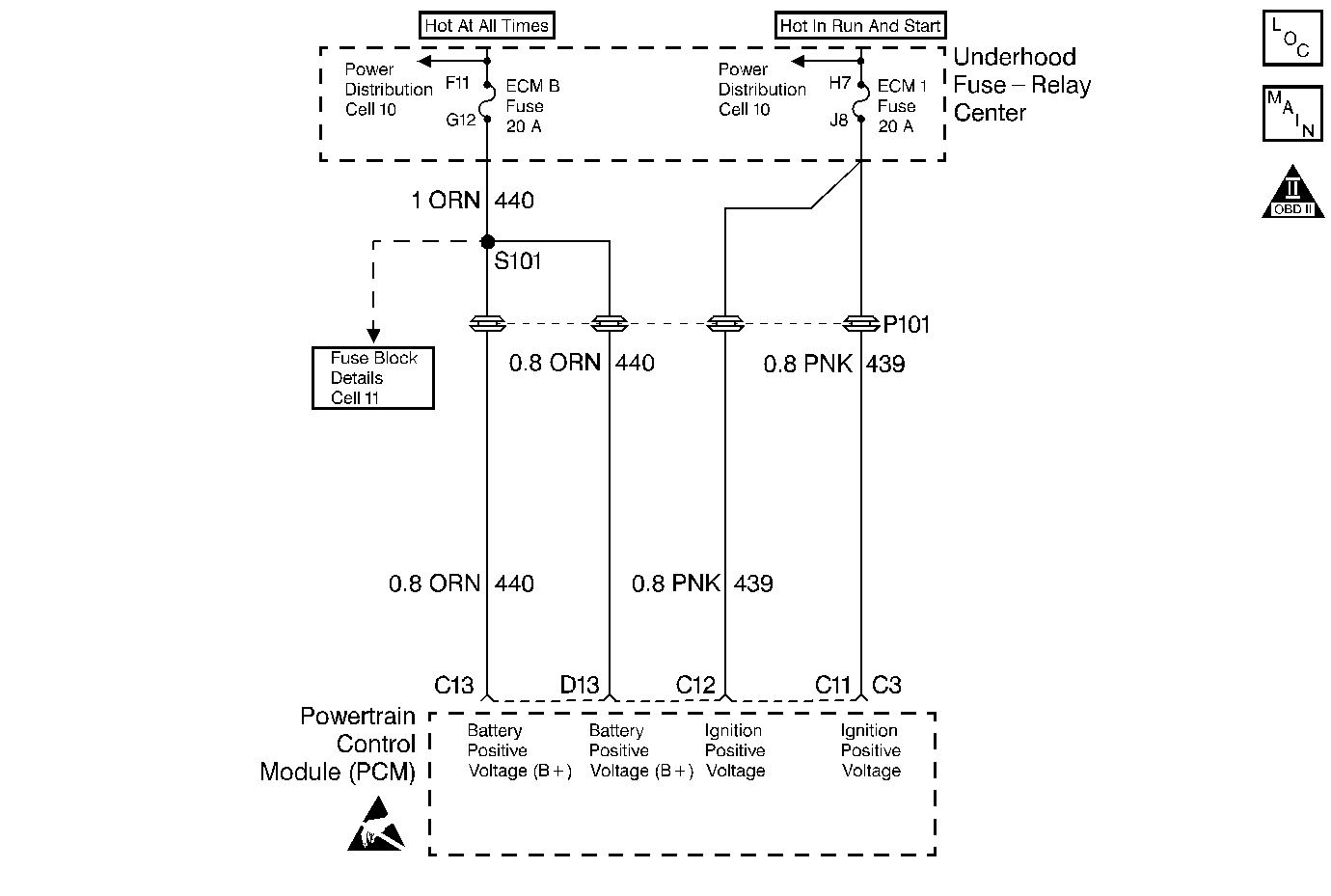DTC P0560 System Voltage 5.7L and 7.5L Gas

Circuit Description
The circuits 439 and 441 are the ignition voltage feeds for the VCM. Circuit 440 is the battery voltage feed for the VCM.
When the VCM detects a low voltage, a high voltage for a long time, or a high voltage for a short time, then DTC P0560 sets. DTC P0560 is a type "D" DTC.
Conditions for Setting the DTC
System Voltage Low:
| • | The engine speed is greater than 1500 RPM. |
| • | The system voltage is less than 10.5 volts at a maximum transmission temperature of 152° C (305° F). |
| • | The system voltage is less than 6.7 volts at a minimum transmission temperature of -40° C (-40° F). |
| • | All conditions met for 4 seconds. |
If the system voltage is high then the system voltage is greater than 19 volts for 4 seconds.
Action Taken When the DTC Sets
| • | The VCM causes an immediate landing to second gear. |
| • | The VCM turns off the PC Sol. Valve. |
| • | The VCM inhibits the TCC engagement. |
| • | The VCM freezes the shift adapts. |
| • | The VCM does not illuminate the Malfunction Indicator Lamp (MIL). |
Conditions for Clearing the DTC
| • | A scan tool can clear the DTC from the VCM history. The VCM clears the DTC from the VCM history if the vehicle completes 40 warm-up cycles without a failure reported. |
| • | The VCM cancels the DTC default actions when the fault no longer exists. |
| • | The VCM cancels the DTC default actions when the ignition is cycled OFF long enough to power down the VCM. |
Diagnostic Aids
| • | Charging the battery with a battery charger and jumpstarting an engine may set this DTC. |
| • | If this DTC is set when an accessory is operated, inspect for faulty connections or an excessive current draw. |
| • | Inspect for faulty electrical connections at the starter solenoid. |
| • | Inspect for faulty electrical connections at the fusible link. |
| • | Inspect for loose or damaged terminals at the generator. |
| • | Inspect the generator belt wear and the generator belt tension. |
| • | First diagnose and clear any engine DTCs or TP Sensor codes that are present. Then inspect for any transmission DTCs that may have reset. |
Test Description
-
This step tests the charging system voltage.
-
This step tests the battery voltage input at the VCM.
-
This step tests the ignition voltage inputs at the VCM.
Step | Action | Value(s) | Yes | No | ||||||
|---|---|---|---|---|---|---|---|---|---|---|
1 | Was the Powertrain On-Board Diagnostic (OBD) System Check performed? | -- | ||||||||
2 |
Important: Before clearing the DTCs, use the scan tool in order to record the Freeze Frame and Failure Records for reference. The Clear Info function will erase the data. Is the voltage higher than the specified value? | 10.5 volts | Go to Engine Electrical, Section 6. | |||||||
3 |
Is the generator lamp ON? | -- | Go to Engine Electrical, Section 6. | |||||||
Is the system voltage within the specified range? | 13-15 volts | Go to Engine Electrical, Section 6. | ||||||||
Is there a voltage variance between the voltage measured at the battery (taken in Step 2) and at terminal C3-21 that is greater than the specified value? | 0.5 | |||||||||
6 | Repair the high resistance condition in circuit 440. Refer to Electrical Diagnosis, Section 8. Did you repair the circuit? | -- | -- | |||||||
Is there a voltage variance between the voltage measured at the battery (taken in Step 2) and at terminals C4-18 and C4-13 that is greater than the specified value? | 0.5 volts | |||||||||
8 | Repair the high resistance condition in circuit 439 or circuit 441 as applicable. Refer to Electrical Diagnosis, Section 8. Did you repair the circuit? | -- | -- | |||||||
9 |
Did you find a problem? | -- | ||||||||
10 | Replace the VCM. Refer to Section 6. Is the replacement complete? | -- | -- | |||||||
11 | In order to verify your repair, perform the following procedure:
Has the test run and passed? | -- | System OK |
DTC P0560 System Voltage 6.5L Diesel

Circuit Description
Circuit 439 is the ignition voltage feed for the PCM. Circuit 440 is the battery feed for the PCM.
When the PCM detects a low voltage, a high voltage for a long time, or a high voltage for a short time, then DTC P0560 sets. DTC P0560 is a type D DTC.
Conditions for Setting the DTC
System Voltage Low:
| • | The engine speed is greater than 1500 RPM. |
| • | The system voltage is less than 10.5 volts at a maximum transmission temperature of 152° C (305° F). |
| • | The system voltage is less than 6.7 volts at a minimum transmission temperature of -40° C (-40° F). |
| • | All conditions met for 4 seconds. |
If the system voltage is high then the system voltage is greater than 19 volts for 4 seconds.
Action Taken When the DTC Sets
| • | The PCM causes an immediate landing to second gear. |
| • | The PCM turns off the PC Sol. Valve. |
| • | The PCM inhibits the TCC engagement. |
| • | The PCM freezes the shift adapts. |
| • | The PCM does not illuminate the Malfunction Indicator Lamp (MIL). |
Conditions for Clearing the DTC
| • | A scan tool can clear the DTC from the PCM history. The PCM clears the DTC from the PCM history if the vehicle completes 40 warm-up cycles without a failure reported. |
| • | The PCM cancels the DTC default actions when the fault no longer exists. |
| • | The PCM cancels the DTC default actions when the ignition is cycled OFF long enough to power down the PCM. |
Diagnostic Aids
| • | Charging the battery with a battery charger and jumpstarting an engine may set DTCs. |
| • | If this DTC is set when an accessory is operated, inspect for faulty connections or an excessive current draw. |
| • | Inspect for faulty electrical connections at the starter solenoid. |
| • | Inspect for faulty electrical connections at the fusible link. |
| • | Inspect for loose or damaged terminals at the generator. |
| • | Inspect the generator belt wear and the generator belt tension. |
| • | First diagnose and clear any engine DTCs or APP Sensor codes that are present. Then inspect for any transmission DTCs that may have reset. |
Test Description
-
This step tests the charging system voltage.
-
This step tests the battery voltage input at the PCM.
-
This step tests the ignition voltage inputs at the PCM.
Step | Action | Value(s) | Yes | No | ||||||
|---|---|---|---|---|---|---|---|---|---|---|
1 | Was the Powertrain On-Board Diagnostic (OBD) System Check performed? | -- | ||||||||
2 |
Important: Before clearing the DTCs, use the scan tool in order to record the Freeze Frame and Failure Records for reference. The Clear Info function will erase the data. Is the voltage higher than the specified value? | 10.5 volts | Go to Step 3 | Go to Engine Electrical, Section 6 | ||||||
3 |
Is the generator lamp ON? | -- | Go to Engine Electrical, Section 6 | Go to Step 4 | ||||||
Is the system voltage within the specified range? | 13-15 volts | Go to Step 5 | Go to Engine Electrical, Section 6 | |||||||
Is there a voltage variance between the voltage measured at the battery (taken in Step 2) and at terminal C3-C13 that is greater than the specified value? | 0.5 | Go to Step 6 | Go to Step 7 | |||||||
6 | Repair the high resistance condition in circuit 440. Refer to Electrical Diagnosis, Section 8. Did you repair the circuit? | -- | Go to Step 11 | -- | ||||||
Is there a voltage variance between the voltage measured at the battery (taken in Step 2) and at terminals C3-C11 that is greater than the specified value? | 0.5 volts | |||||||||
8 | Repair the high resistance condition in circuit 439. Refer to Electrical Diagnosis, Section 8. Did you repair the circuit? | -- | -- | |||||||
9 |
Did you find a problem? | -- | ||||||||
10 | Replace the PCM. Refer to Powertrain Control Module Replacement/Programming Section 6. Is the replacement complete? | -- | -- | |||||||
11 | In order to verify your repair, perform the following procedure:
Has the test run and passed? | -- | System OK | Begin diagnosis again. Go to Step 1 |
